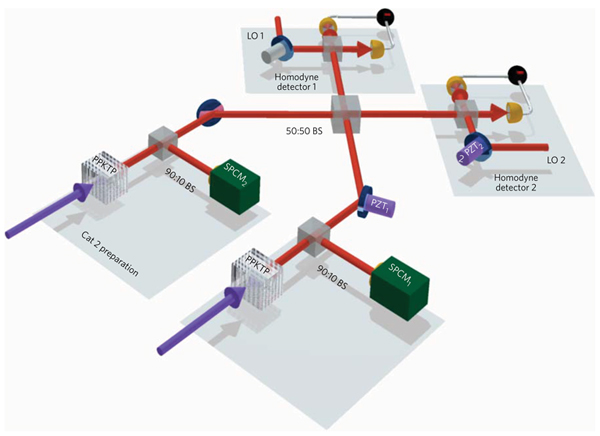How to breed Schrödinger’s cats
Alexander Lvovsky is a physicist, a CIFAR Quantum Information Science Fellow and most recently, a Schrödinger’s cat breeder.
In 1935, German physicist Erwin Schrödinger proposed a thought experiment where a cat, hidden from the observer, is in a superposition of two states: it is both alive and dead. Schrödinger’s cat was intended to show how radically different the macroscopic world we see is from the microscopic world governed by the laws of quantum physics.
However, with recent advances, Schrödinger’s thought experiment no longer seems as unrealistic.
Modern physicists use “Schrödinger cats” to mean objects in a quantum superposition of two states with opposite properties. In optics, this is a superposition of two classical states of light where the fields of the electromagnetic waves point in opposite directions at once.
Physicists have been able to generate small Schrödinger cat states, but current methods limit their size to three to four photons. In order to create larger, higher-energy states, Lvovsky’s team of University of Calgary and Russian Quantum Center scientists sought out to combine these states. Their results were published in Nature Photonics.
“We developed a technique to construct a larger Schrodinger cat state out of smaller ones,” Lvovsky explains.
The idea of the Schrödinger cat breeding experiment was first proposed in a 2003 article by University of Queensland physicist Timothy Ralph. The experiment relies on causing interference of two cats on a beam splitter. This leads to an entangled state in the two output channels of that beam splitter. In one of these channels, a special detector is placed. In the event this detector shows a certain result, a cat is born in the second output whose energy is more than twice that of the initial one.

At the Russian Quantum Center’s Optics Lab, Lvovsky’s team successfully converted a pair of negative squeezed Schrödinger cats into a larger positive one. They saw an increase from 1.3 to 3.4 photons on average, which is comparable with the largest optical Schrödinger cats ever produced by other methods. They generated several thousand such enlarged cats in their experiment.
While the experiment has not yet yielded the biggest Schrödinger cat state, it demonstrates a method that could be used to obtain one. Lvovsky says this instrument could allow physicists to breed these larger cats into even bigger ones that would ultimately be visible to the naked eye.
The study addresses a question at the heart of Lvovsky’s research : At what point do the laws of quantum physics yield to classical physics?
“We want to enlarge the cats until we stop seeing quantum effects. Maybe we’ll never stop seeing them, who knows,” Lvovsky says, adding that there is no experimental evidence that would tell us whether the laws of quantum physics are universal or if they stop working at a certain degree of macroscopicity.
In addition to probing the boundary between the quantum and classical worlds, macroscopic Schrödinger cat states would have applications in quantum communications, teleportation and cryptography.
For now, Lvovsky is taking a break from breeding Schrödinger cats to take on another challenge.
His new experiment focuses on building an entangled state between a Schrödinger cat and the polarization of a single photon. Polarized photons and Schrödinger cat states are two ways of encoding quantum information. These encodings have different benefits and this experiment would look at how to convert one into the other so the fortes of both approaches can be exploited at once.
“Enlargement of optical Schrödinger’s cat states” was published in Nature Photonics May 1, 2017.
Related Ideas
CIFAR Research Workshops: Call for Proposals
For more than three decades, CIFAR’s global research programs have connected many of the world’s best minds – across borders...
How to breed Schrödinger’s cats
Alexander Lvovsky is a physicist, a CIFAR Quantum Information Science Fellow and most recently, a Schrödinger’s cat breeder. In 1935,...
Raymond Laflamme awarded CAP-CRM Prize
CIFAR Senior Fellow Raymond Laflamme was awarded the 2017 CAP-CRM Prize in Theoretical and Mathematical Physics for his ground-breaking work...
Times Higher Education: Interview with Louis Taillefer
“We talk misconceptions about quantum physics, the importance of global research collaboration and Nobel prize aspirations with the award-winning Canadian...
Physicists discover a way to increase the resolution of microscopes and telescopes
Physicists have found a way to increase the resolution of microscopes and telescopes beyond long-accepted limitations by tapping into previously...
Quantum Teleportation Across a Metropolitan Fibre Network
Quantum teleportation allows quantum states to be, in principle, teleported over arbitrarily long distances and has several applications in communication...
CancelRespond